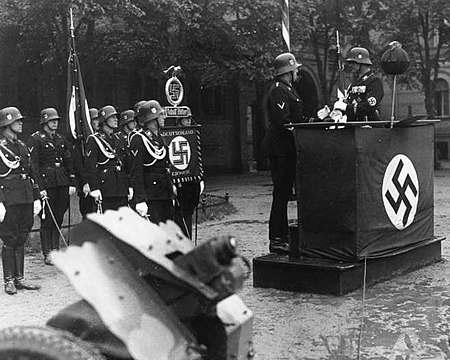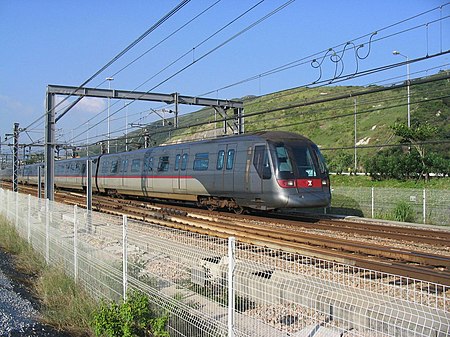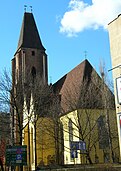Polish Orthodox Church
| ||||||||||||||||||||||||||||||||||||||||||||||||||||||
Read other articles:

Basilika Bunda DukacitaBasilika Minor Bunda Dukacitabahasa Polandia: Bazylika kolegiacka Matki Boskiej Bolesnej w LimanowejBasilika Bunda DukacitaLokasiLimanowaNegara PolandiaDenominasiGereja Katolik RomaArsitekturStatusBasilika minorStatus fungsionalAktif Basilika Bunda Dukacita (bahasa Polandia: Bazylika kolegiacka Matki Boskiej Bolesnej w Limanowej) adalah sebuah gereja basilika minor Katolik yang terletak di Limanowa, Polandia. Basilika ini ditetapkan statusnya pada 1991 dan did…

1656 alliance between Austria and Poland–Lithuania Treaty of ViennaFerdinand III, Holy Roman EmperorTypeOffensive allianceDrafted1 December 1656Signed30 March 1657 (1657-03-30)LocationVienna, Archduchy of AustriaSignatories Ferdinand III, Holy Roman Emperor John II Casimir Vasa Parties House of Habsburg Polish-Lithuanian Commonwealth The treaty of Vienna, concluded on 1 December 1656, was an Austro–Polish alliance during the Second Northern War.[1] Habsburg emper…

2011 anime series directed by Tatsuyuki Nagai Anohana: The Flower We Saw That DayFirst DVD volume cover featuring Jinta (left) and Menmaあの日見た花の名前を僕達はまだ知らない。(Ano Hi Mita Hana no Namae o Bokutachi wa Mada Shiranai)GenreComing-of-age[1]Created bySuper Peace Busters:Tatsuyuki NagaiMari OkadaMasayoshi Tanaka Serial novelWritten byMari OkadaPublished byMedia FactoryImprintMF Bunko Da VinciMagazineDa VinciOriginal runMarch 2011 – July 201…

European handball cup competition This article is about the men's competition. For the women's competition, see Women's EHF European Cup. EHF European CupCurrent season, competition or edition: 2023–24 EHF European CupSportHandballFounded1993No. of teams50 (total)CountryEuropeConfederationEHF membersMost recentchampion(s) Vojvodina(1st title)Most titles CS UCM Reşiţa(3 titles)Level on pyramid3Official websiteehfec.eurohandball.com The EHF European Cup is an annual men's handball club competi…

Akibat GodaanSutradaraMatnoor TindaonProduserSabirin KasdaniDitulis olehArifin C. NoerPemeranYati OctaviaRoy MartenRobby SugaraYenny RachmanTorro MargensPenata musikGatot SudartoPenyuntingE. Mukhsin HamzahDistributorRapi FilmsTanggal rilis1978Durasi99 menitNegaraIndonesia Akibat Godaan adalah film Indonesia tahun 1978 dengan disutradarai oleh Matnoor Tindaon dan dibintangi oleh bintang-bintang besar Roy Marten, Robby Sugara Yati Octavia dan Yenny Rachman. Sinopsis Tentang pergaulan remaja …

ロバート・デ・ニーロRobert De Niro 2011年のデ・ニーロ生年月日 (1943-08-17) 1943年8月17日(80歳)出生地 アメリカ合衆国・ニューヨーク州ニューヨーク市身長 177 cm職業 俳優、映画監督、映画プロデューサージャンル 映画、テレビドラマ活動期間 1963年 -配偶者 ダイアン・アボット(1976年 - 1988年)グレイス・ハイタワー(1997年 - )主な作品 『ミーン・ストリート』(1973年)『…

Military branch of the Nazi SS Not to be confused with Schutzstaffel or Wehrmacht. Waffen-SSWaffen-SS troops in the Soviet Union, 1941Active17 March 1933–10 May 1945Country GermanyAllegiance Adolf HitlerBranchSchutzstaffelTypePanzerdivisionPanzergrenadierSS-Kavallerie-BrigadeGebirgsjägerSize900,000 including foreign volunteers and conscripts[1] List of Waffen SS unitsPart ofSS: under operational control of the OKW and Kommandostab Reichsführer-SSGarrison/HQSS-Führungshaupt…

ABB Daimler Benz TransportationDaimlerChrysler Rail Systems(ADtranz)JenisPerusahaan patunganIndustriTransportasi relNasibDigabung ke dalam BombardierPenerusBombardier TransportationKini AlstomDidirikan1996 (melalui penggabungan)PendiriABBDaimler-BenzDitutup2001KantorpusatBerlin, Germany[1]TokohkunciRolf Eckrodt (Presiden 1992-6, Chairman 1996-8)[2]ProdukKendaraan rel, elektrifikasi perkeretaapian, dan persinyalan kereta apiPendapatanDM5,7 milyar (1996)[3]DM6,4 milyar (199…

United States historic placeHull's Trace North Huron River Corduroy SegmentU.S. National Register of Historic Places Corduroy segment, image taken from Harbin Drive bridge looking north up Silver CreekInteractive mapLocation36000 W Jefferson Ave, Brownstown Charter Township, MichiganCoordinates42°2′48″N 83°12′43″W / 42.04667°N 83.21194°W / 42.04667; -83.21194Built1812ArchitectWilliam HullArchitectural styleCorduroy roadNRHP reference No.10001022…

1900年美國總統選舉 ← 1896 1900年11月6日 1904 → 447張選舉人票獲勝需224張選舉人票投票率73.2%[1] ▼ 6.1 % 获提名人 威廉·麥金利 威廉·詹寧斯·布賴恩 政党 共和黨 民主党 家鄉州 俄亥俄州 內布拉斯加州 竞选搭档 西奧多·羅斯福 阿德萊·史蒂文森一世 选举人票 292 155 胜出州/省 28 17 民選得票 7,228,864 6,370,932 得票率 51.6% 45.5% 總統選舉結果地圖,紅色代表麥�…

Panasonic Gobel Awards 2019Poster Panasonic Gobel Awards 2019DisponsoriPanasonicTanggalJumat, 6 Desember 2019LokasiThe Opus Grand Ballroom, The Tribrata Dharmawangsa, Jalan Darmawangsa Tiga, Pulo, Kebayoran Baru, Jakarta SelatanNegara IndonesiaPembawa acaraRina NoseRuben OnsuPembawa pra-acaraUusShafira UmmPenampilanIwan FalsSoundwaveFildan RahayuLesti KejoraTiara RamadhaniIkhtisarPenghargaan terbanyakRCTI (6)Nominasi terbanyakIndosiarSCTV (18)Sinetron SerialTukang Ojek PengkolanPemeran Pria…

本表是動態列表,或許永遠不會完結。歡迎您參考可靠來源來查漏補缺。 潛伏於中華民國國軍中的中共間諜列表收錄根據公開資料來源,曾潛伏於中華民國國軍、被中國共產黨聲稱或承認,或者遭中華民國政府調查審判,為中華人民共和國和中國人民解放軍進行間諜行為的人物。以下列表以現今可查知時間為準,正確的間諜活動或洩漏機密時間可能早於或晚於以下所歸類�…

Pour les articles homonymes, voir Brumes. Brumes De g. à d. : Pat O'Brien, Martha Tibbetts, James Cagney, June Travis et Stuart Erwin (photo promotionnelle) Données clés Titre original Ceiling Zero Réalisation Howard Hawks Acteurs principaux James CagneyPat O'BrienJune TravisStuart Erwin Sociétés de production Warner Bros Pays de production États-Unis Genre Film d'aventure Durée 95 minutes (1 h 35) Sortie 1936 Pour plus de détails, voir Fiche technique et Distributio…

Principali oggetti non stellari presenti nella costellazione di Orione. Mappa della costellazione di Orione. Dettaglio delle regioni centrali. Indice 1 Ammassi aperti 2 Nebulose oscure 3 Sorgenti radio 4 Oggetti di Herbing-Haro 5 Nebulose diffuse 6 Ammassi di galassie Ammassi aperti Cr 65 Cr 69 Cr 70 (Cintura di Orione) NGC 1662 NGC 1980 NGC 1981 NGC 2112 NGC 2141 NGC 2169 NGC 2175 NGC 2186 NGC 2194 Trapezio Nebulose oscure LDN 1616 Nebulosa Testa di Cavallo Sorgenti radio GR 0550+08 Oggetti di …

هيمنا Hemne هيمنا هيمناشعار النبالة لبلدية هيمنا موقع هيمنا بالنسبة لسور تروندلاغ تاريخ الإلغاء 31 ديسمبر 2019 تقسيم إداري البلد النرويج[1] مقاطعة سور تروندلاغ المسؤولون خصائص جغرافية إحداثيات 63°16′16″N 9°03′21″E / 63.271111111111°N 9.0558333333333°E / 63.271111111111; 9.0558333333333 […

British politician Captain The Right HonourableEuan WallaceMCMinister of TransportIn office1939–1940Preceded byLeslie BurginSucceeded bySir John ReithFinancial Secretary to the TreasuryIn office1938–1939Preceded byJohn ColvilleSucceeded byHarry CrookshankParliamentary Secretary to the Board of TradeIn office1937–1938Preceded byLeslie BurginSucceeded byRonald CrossSecretary for Overseas TradeIn office1935–1937Preceded byJohn ColvilleSucceeded byRobert HudsonUnder-Secretary of State for th…

Nanette Barragán Membro della Camera dei rappresentanti - California, distretto n.44In caricaInizio mandato3 gennaio 2017 PredecessoreJanice Hahn Dati generaliPartito politicoDemocratico Nanette Diaz Barragán (Los Angeles, 15 settembre 1976) è una politica statunitense, membro della Camera dei Rappresentanti per lo stato della California. Indice 1 Biografia 2 Note 3 Altri progetti 4 Collegamenti esterni Biografia Figlia di immigrati messicani, Nanette Barragán crebbe a Carson, in C…

Questa voce o sezione sull'argomento motori aeronautici non cita le fonti necessarie o quelle presenti sono insufficienti. Puoi migliorare questa voce aggiungendo citazioni da fonti attendibili secondo le linee guida sull'uso delle fonti. Segui i suggerimenti del progetto di riferimento. Schema di motore turboelica Turboelica (in inglese turboprop) è un motore aeronautico costituito da un'elica aeronautica azionata da una turbina. Differisce dal motore aeronautico a getto, in quanto nei mo…

This biography of a living person relies on a single source. You can help by adding reliable sources to this article. Contentious material about living people that is unsourced or poorly sourced must be removed immediately. (April 2022) (Learn how and when to remove this message) In this Chinese name, the family name is Chan (陳). Chan Kwong-wingChan in an interview for the film The Captain in 2019Born (1967-06-15) 15 June 1967 (age 56)Hong KongOccupationMusic composerAwardsHong Kong Film …

French novelist and art critic (1848–1907) Joris–Karl HuysmansHuysmans, c. 1895BornCharles-Marie-Georges Huysmans(1848-02-05)5 February 1848Paris, FranceDied12 May 1907(1907-05-12) (aged 59)Paris, FranceOccupationNovelistGenreFictionLiterary movementDecadentNotable worksÀ rebours (1884) Là-bas (1891) En route (1895) La cathédrale (1898)Signature Charles-Marie-Georges Huysmans (US: /wiːsˈmɒ̃s/,[1] French: [ʃaʁl maʁi ʒɔʁʒ ɥismɑ̃s]; 5 February 1848 �…









